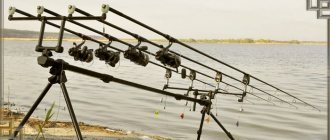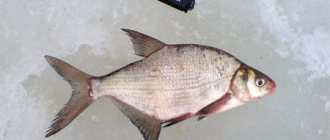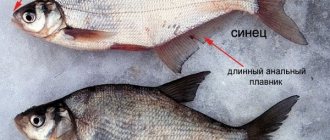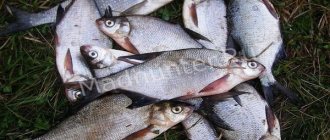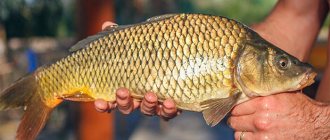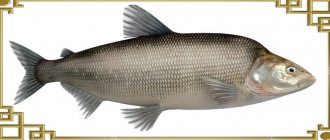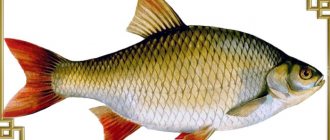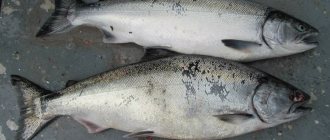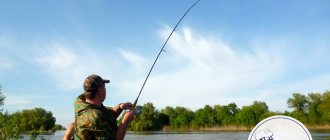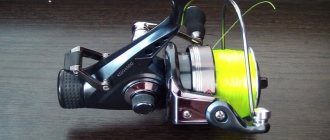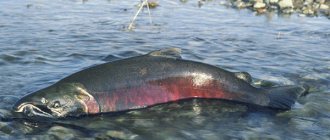Species of mullet living in the Black Sea
Systematically, the mullet belongs to the following categories:
- Class - Ray-finned fish,
- Order - Mullet-shaped,
- Family - Mullet,
- Genus - Gray mullet.
Today, four species of mullet live in the Black Sea waters. They all have a similar appearance and differ only in body size, weight and features associated with the breeding season. So, in the Black Sea they live:
- Loban,
- Singil,
- Pelengas,
- Sharp nose (chularka),
Fish of different species appeared in the Black Sea waters for various reasons. Three of them - mullet, singil, sharpnose - are indigenous inhabitants of the warm waters of the Black Sea coast. Pelengas was brought specially from the Sea of Japan. This was done in order to correct the deplorable situation of the Black Sea mullet, whose numbers were sharply declining due to the deteriorating environmental situation due to human activity and uncontrolled fishing.
Pelengas firmly occupied its niche, took root and increased its numbers. Many feared that the imported species would supplant the home-grown one, but this did not happen. On the contrary, over time, the numbers of the indigenous inhabitants of the Black Sea - mullet, singil and chularka - have also recovered.
Comparative table of species
| Type of mullet | Body mass | Size | A comment |
| Mullet (striped mullet) | Up to 7 kg (average weight - 2.5−3 kg) | Up to 90 cm (average size - 50 cm) | The largest mullet. Leads a gregarious lifestyle. It feeds on organic matter that forms bottom silt. Capable of developing high speed. Spawns from late May to early August. Fry and juveniles prefer shallows and river mouths, where they live until the first autumn cold. |
| Singil | Up to 1 kg | Up to 35 cm | In many ways it is similar to mullet, but is much smaller in size. In its life cycle it makes long migrations and often enters estuaries. The most numerous inhabitant of the Black Sea waters. |
| Sharp-nose (chularka) | Up to 700 g | Up to 30 cm | The smallest representative of the mullet. |
| Pelengas | Up to 1.5 kg | Up to 45 cm | Specially brought from the waters of the Sea of Japan, it is the most unpretentious among all mullets. |
Pelengas mullet (Мugil so-iuy)
mullet-pelengas
(in Japan this type of mullet is called maenad, and in China so-yu), previously living in the Far East - in the Peter the Great Gulf, in the Amur Bay, in the Ussuri Bay, in the north - to the Amur Estuary, as well as in the south of the Korean Peninsula ( Chemulpo, Chifi), in 1972-1976 was successfully acclimatized in the Shabolatsky estuary of the Black Sea to conduct experiments on its cultivation using pasture and pond aquaculture. Also during these years, a feeding and reproduction farm was created on the basis of the Shabolat estuary, which is still functioning. When introducing the pelengas, two main goals were initially set: the formation of a self-reproducing population in the Black Sea and adjacent estuaries, as well as the creation of a replacement broodstock in controlled conditions, i.e., ponds. It should be noted that estuary mullet farming in the Black Sea basin has a centuries-old history. For mullet-growing farms, they mainly used estuaries located in the northwestern part of the Black Sea from the Danube to the Tendra Spit, and some reservoirs in the eastern part between the entrance to the Kerch Strait and Anapa. There were also small mullet farms in the Crimea (Lake Tobechik, Uzunlar, Donuzlav) and on the Caucasian coast (Lake Paleostomi, Nurie-Gel).
The principles of pasture mullet farming were simple and did not change for centuries. In the spring, yearlings of mullet, mostly singil, weighing from 0.5 to 3.5 grams, having overwintered in the sea, entered from the sea through channels, breaks and artificial channels into quickly warming estuaries, abundant in food. By autumn, in most reservoirs, mullet grew to an average of 100-150 grams. Its growth rate depends on many conditions: temperature, salinity (low salinity, about 12-16 ppm, promotes growth), species composition of the grown mullet (the highest growth rate is for mullet, the lowest for singil), stocking density, natural productivity reservoirs and other factors. In 1955, on the basis of Kiziltash. In the Bugaz and Tsokur estuaries (Taman Peninsula), with a total area of 24.4 thousand hectares, a large commercial mullet farm was created for pasture cultivation of mullet and singil in artificially created biological conditions. Currently, the Kiziltash feeding and reproduction mullet farm (NVKH) is the only enterprise in the south of Russia for feeding and growing pelengas, mullet and singil. It should be noted that such farms stock their feeding reservoirs with juveniles by catching mullet from natural populations (mullet, singil), the number of which is at a low level. It has been established that in the Azov basin and the Black Sea estuaries, the heat-loving mullet does not overwinter, and therefore special attention is focused on the more cold-resistant acclimatizantepelengas, which is sufficiently eurythermic (i.e., adapted to living in different temperature conditions) for mariculture. In fact, since that time, the population of this species of artificially stocked mullet has been dominant in its numbers in the Black Sea and successfully competes with mullet, singil, sharpnose and bighead.
The productivity of a commercial mullet farm engaged in breeding pelengas can be 50-100 kg of fish per hectare, and in the warmest lagoons even 300-350 kg per hectare. Mullet is bred in Russia in several ways. Typically, the pasture-based aquaculture method is used, when they raise one-year-old fish that have overwintered at sea and entered the estuary. It is also possible to catch young mullet during its migration and place it in the estuary for feeding. In this case, in the fall, when the fish leave the estuary for the sea, mullet that has reached marketable weight is caught. Another option (the so-called polyculture) also involves catching young mullet in the sea and placing them in reservoirs inhabited by carp or other fish. More complex methods involve breeding producers in ponds or other devices to obtain offspring from them under the control of fish farmers and further cultivation. The direction of artificial reproduction of pelengas mullet with the subsequent placement of its young in ponds or other reservoirs for rearing is considered promising. The most intensive increase in marketable mass is produced by pelengas, at 3-4 years of age (0.3-0.5 kg), then the growth rate decreases. The fastest growing mullet fish is the mullet, however, methods for artificial reproduction of this species in Russia have not yet been fully developed. In parallel with the breeding of mullet in fish farms, active fishing for singil, mullet, and sharpnose is carried out everywhere in the Black Sea from April 1 to July 1 and from August 15 to December 31 by seiners using fixed and ring seines, mullet lifting factories, fixed mesh nets 50-70 mm, with the exception of the Kiziltash estuaries system. Industrial fishing for pelengas in the Black Sea continues throughout the year, without step-by-step prohibitions, with the exception of the spawning period. For a more complete acquaintance with the living species of mullet in the Black Sea, below are pictures and their characteristics.
Scallop, mullet, black mullet (Mugil cephalus)
mullet
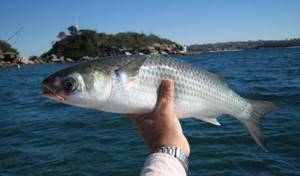
Characteristics: An elongated fusiform body with 2 short dorsal fins and a wide, strongly flattened head. Small terminal mouth with narrow lips. Eyes with fatty eyelids (unlike all other European mullets, covers the entire eye up to the pupil). Large, round scales also covering the head, 42 in one longitudinal row. There is no pronounced lateral line. There is an arrow-shaped spot on the underside of the head. Color: the back is ash-gray with a golden or blue metallic sheen, the sides with 9-10 dark longitudinal lines, the belly is whitish. The pelvic and pectoral fins are gray with a metallic tint. Dimensions: length 30-50 cm, max. up to 90 cm, weight up to 6.5 kg. Usually you come across individuals 25-35 cm, weighing 0.4-1.0 kg. Distribution: Permanently inhabiting the Black Sea, in winter, moving away from the coastal zone to deeper places. Currently, the population of this species is declining due to a number of natural and environmental factors (up to 5% of catches). From April to October, the mullet fattens in shallow areas of the coast, lagoons, estuaries and estuarine areas of mountain rivers. In summer, in search of food, it can come in flocks close to the shore, to a depth of 2 meters, filtering silt in shallow areas of the seabed. Reaches sexual maturity at the age of 6-8 years, with a length of 30-40 cm. Spawning is portioned, in May-September. The mullet is an excellent maneuverable swimmer; in the aquatic environment it is capable of maintaining a speed of up to 0.5 m/sec for a long time, and briefly developing it up to 6.5 m/sec. It lives in Lake Paleostomi (area 17 km2 and salinity about 13 ppm), connected to the Black Sea through the Pichora River (Adjara). Important commercial fish and aquaculture species. Food: worms, mollusks, crustaceans, filtered from silt.
Singil, sarianak, serenade (Liza aurata)
mullet-singile
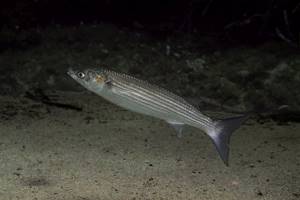
Characteristics: Elongated fusiform body with 2 short dorsal fins and a wide head. Unlike the mullet, the singil has poorly developed fatty eyelids (developed only at the edges of the eye); the snout to the hind nostrils is bare, without scales; there is no elongated lobe at the base of the pectoral fins; The grooves of the lateral line system on the scales of the upper part are ordinary. Color: the back is dark gray, often with a blue tint, the sides and belly are light or silver; there are several narrow golden stripes on the sides of the body; a large golden spot on the top of the operculum that disappears after death. Dimensions: length up to 55 cm, weight up to 4 kg. Typically, catches are 20-35 cm long and weigh 0.3 - 1.0 kg. Distribution: Permanently inhabiting the Black Sea, in winter, moving away from the coastal zone to deeper places. Its lifestyle is similar to mullet; it can also be found in fresh and brackish water near river mouths. Reaches sexual maturity at the age of 3-4 years. Spawning takes place in the open sea in July-October. Singil is an important object of industrial fishing (up to 30% of the catch) and fish farming in commercial mullet farms (mainly in Ukraine and Crimea). Recently, the stocks of singil in the Black Sea have begun to recover, and the total number of individuals of this mullet species has begun to exceed the population of mullet. It should be noted that singil is also found in Lake Paleostomi (area 17 km2 and salinity about 13 ppm), connected to the Black Sea through the Pichora River (Adjara). Food: worms, mollusks, etc. filtered from sludge.
Sharpnose, chularka, larich (Liza saliens)
pointy mullet
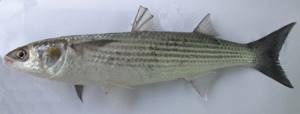
Characteristics: An elongated fusiform body with 2 short dorsal fins and a gradually tapering head with a sharp snout. The head is bare only in the very front part (up to the front nostrils). On the scales of the back and the posterior part of the upper part of the head there are several (2-5) grooves of the lateral line system; the fatty eyelid is weakly expressed in the eyes. The notch (notch) on the caudal fin is less pronounced than that of the singil and mullet and has the appearance of a crescent. Color: typical for all mullets, the back is gray, the sides are light with a silver tint. There is no golden spot on the upper part of the operculum. Dimensions: the smallest species of Black Sea mullet, reaching a weight of 2 kg with a length of 40 cm. Usually in catches up to 20 cm and weighing 100-250 grams. Distribution: Permanently inhabiting the Black Sea, winters in the open sea. Its lifestyle is similar to other types of mullet. Reaches sexual maturity in the 3rd year of life. Spawning takes place in the open sea, above depths of 20-700 meters, in August-September. Recently, due to overfishing, the sharpnose population has been decreasing; specimens weighing 1 kg or more are becoming less and less common. Schools of sharpnose fatten mainly on sandbanks (banks), rarely on reef and rocky areas of the seabed. It has little commercial significance at present (up to 15%) in catches. Food: worms, mollusks, etc. filtered from bottom silt.
Pelengas (Mugil so-iuy Basilewsky or Liza haematochila Temminck & Schlegel)
mullet-pelengas
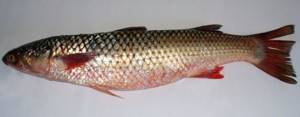
Characteristics: An elongated fusiform body with 2 short dorsal fins and a wide, strongly flattened head. He has poorly developed fatty eyelids. There is no elongated lobe at the base of the pectoral fins; the head is bare only in the very anterior part, up to the level of the anterior nostrils. The caudal fin is slightly concave, unlike the mullet and singil. There is a dark spot at the posterior edge of each scale. Color: the back, unlike other mullets, has a darker color, usually dark gray with a black tint. The sides and belly are white and silver. There is no golden spot on the upper part of the operculum. Dimensions: as a result of successful acclimatization in the Black Sea, the weight and length of the pelengas exceed their previous natural ones when living in the estuaries of the Far East. Currently, pelengas can reach 1 m, weighing up to 6 kg. Typically, catches are up to 40 cm long and weigh 3 kg. Under industrial breeding conditions, individuals of pelengas at the age of 3-4 years reach a mass of more than 1.5 kg. Distribution: Acclimatization in the Black Sea of the Far Eastern mullet - the first detritivore in the European part of the CIS - has great prospects. Moreover, this fish, compared to other types of mullet, is characterized by high ecological plasticity. This circumstance is the leading one when carrying out work on the introduction of pelengas in the Black Sea in conditions of anthropogenic destruction of the environment and mass death in natural conditions of a large number of local mullet. The main goal of acclimatization of pelengas is to increase the fish productivity of natural reservoirs by creating self-reproducing populations in the sea. In September-October, the pelengas come very close to the shore to feed, usually in shallow areas of the seabed (capes, banks, river estuaries). When fishing during the autumn fishing season, it accounts for up to 50% of the catch. Nutrition: detritus, periphyton.
Golovach, ramada (Liza ramado Risso)
mullet ramada
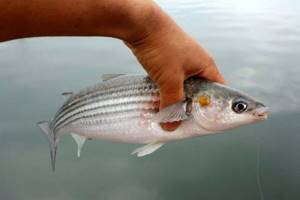
Characteristics: An elongated fusiform body with 2 short dorsal fins and a gradually tapering head with a sharp snout. Fatty eyelids are in their infancy. The scales on the head reach the anterior nostrils. Small mouth opening, no teeth. Adults have rows of small warts on their thin lips. Large round scales, without a clear lateral line. Distinctive features of the ramada: a weakly concave caudal fin with a large crescent shape, and also a dark spot at the base of the pectoral fin. Color: the back is dark, blue-gray on top, lighter on the sides, with 7-8 narrow longitudinal dark stripes; belly silvery; the fins are dark gray with a metallic sheen. Dimensions: max. 70 cm, weight 3 kg, usually in catches 20-25 cm and weighing 0.3-0.5 g. Distribution: The bighead mullet is a subspecies of the Singil and lives mainly in the northwestern part of the Black Sea, and is practically not found off the coast of the Caucasus. The ramada mullet differs from the singil in that it has scales on its head that extend to the front nostrils, as well as a black spot at the base of the pectoral fin. Reaches sexual maturity at 3-4 years of age. Spawning takes place in the open sea in July-October. Until recently, it was the object of intensive fishing off the coasts of Turkey, Bulgaria and Romania, but due to overfishing at the turn of the 80-90s of the last century, its population began to decline rapidly and is considered endangered. In Mediterranean countries it is an object of fishing and fish farming (Israel, Lake Kinneret). Nutrition: periphyton, detritus.
Mullet wrasse, thick-lipped mullet (Chelon labrosus)
thick-lipped mullet
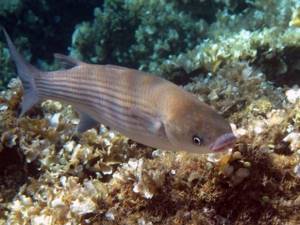
Characteristics: An elongated, spindle-shaped body with two short dorsal fins and a strongly flattened head. There are no fatty eyelids on the eyes. A small mouth opening, no teeth, with a very thick upper lip, with rows of small warts. Large round scales, without a clear lateral line. Narrow neck. The caudal peduncle is strongly notched. Color: The back is dark, gray-green, with a leaden tint. There are 7-8 narrow longitudinal dark stripes on the sides. The belly is silvery, the pectoral and ventral fins are dark gray with a metallic tint. Dimensions: length max. 75 cm, weight 4-5 kg. Distribution: The population of wrasse mullet in the Black Sea, according to scientists, is decreasing from year to year, which is associated with unfavorable environmental factors in the surrounding aquatic environment. The main habitat of thick-lipped mullet is the Eastern Atlantic, the coast of Senegal and Mauritania. Like all mullets, in summer they come to shallow areas of the sea to search for food and go far into rivers. Not found in catches of fishing vessels in Russian territorial waters. Diet: diatoms, detritus, seabed inhabitants.
Appearance
All mullets have an elongated body, somewhat flattened anteriorly. The scales are large. The back has a bluish-gray tint, the ventral part is silver. On the lateral surfaces of the body there are clearly visible longitudinal stripes of brown color. Lateral line organs are absent. This genus has characteristic eyes with a wide eyelid covered with fat, reaching almost to the pupil. Small mouth. The lower lip is thin and has pointed edges. There are deep grooves in the caudal fin. The pectoral fins have a lobe (an elongated fragment of scales) above their base.
Description of mullet
The body of the mullet is elongated, resembling a torpedo. The back is flattened, so the fish's nose is in line with the dorsal fin. The mullet is gray in color, with a silver tint on the belly. The back is darker than the sides, which are covered with longitudinal black stripes.
The scales are round and large. The mullet has two dorsal and pelvic fins, prebranchial and anal, with silver inclusions. The tail is dark gray, with clearly visible notches.
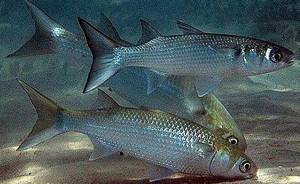
Due to the shape of the body, the Black Sea mullet fish is very mobile and maneuverable. Her head is small, with a sharp nose. The eyes are large, with fatty, wide eyelids. The mouth is small and toothless, with a pointed lower lip. Mullet can grow up to 90 centimeters. The smallest fish is 40 cm. The weight of a mullet can reach 7 kilograms. She lives from 12 to 15 years.
Lifestyle of fish
Mullet has great mobility and primarily leads a gregarious lifestyle. It has the protective ability to jump out of the water in case of danger, and easily overcomes exposed fishing nets, jumping over them.
Reaches sexual maturity at 6–8 years of age. At this point, the length of the body is almost 35−45 cm. It spawns, as a rule, from late May to early September. In terms of reproduction, mullet is quite unpretentious: both open and coastal waters are suitable for it. Like many fish, it has high fertility, laying from 5 to 7 thousand eggs. Eggs and fry swim in the water column, being closer to the surface of the reservoir.
In summer, mullet uses detritus as food - what makes up bottom silt (undecomposed remains of plants and small animals). It can also feed on plants that abundantly populate the seabed, small crustaceans and mollusks, and rarely on worms. During feeding, the mullet moves above the bottom at an angle of 45 degrees and, as it were, scrapes off the top layer of silt from it, using its lower jaw as a shovel.
How to catch mullet on the Black Sea
Choose a place where there are many other fishermen besides you. This is a good sign that there are a lot of fish in this place and you have the opportunity to catch your trophy. It’s best to come fishing in the evening or early morning, when the fish come out to shallow water and feed on coastal mollusks.
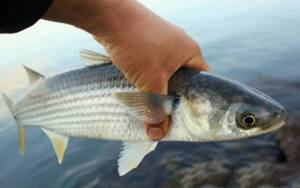
Try to find a place where there are no breakwaters that could spook the fish. A pier or a concrete slab will be the best place for you, and may even prove to be effective. A light breeze should create a slight ripple and slightly cloudy water, which mullet love so much. It is important to understand what bait the fish like and what is best for catching mullet. Experienced mullet fishermen recommend feeding them with balls of fresh bread mixed with salt water.
Features of preparation for casting:
- make bait from freshly baked bread. Form balls that should have weight; for this you can add small sea stones to them;
- throw some balls at the fishing spot;
- use only high-quality tackle and check it before casting;
- use micro carabiners to connect the fishing line and leader;
- Mullet has specific tastes, so use worms, meat, bread, boiled shrimp, and dough as bait.
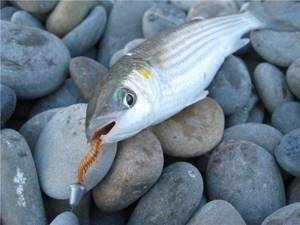
Attention! Do not forget that it is better to catch mullet in good and calm weather and at night, when it gets to the shore.
Mullet recipes
This fish has delicious tender meat, which has many beneficial properties. Mullet is prepared in different forms. Let's look at a few: baked, fried fish and fish soup.
So, to prepare mullet baked in foil we will need the following products:
- Fish carcass - the bigger the better,
- Salt pepper,
- 1 medium onion,
- Half a lemon
- Butter - 20 g.
The main thing in this recipe is to preserve the juiciness of the fish. To do this, it is important not to overexpose it in foil. Then, among other things, the integrity of the skin will be preserved, which will give the dish a special aesthetics.
Wash the carcass in cold water, clean it, remove the insides. Then remove the gills and fins (if this is not done, the dish will taste bitter). We make cuts of medium depth along the entire ridge. Salt and pepper. Let the fish soak up the spices . At this time, cut the lemon and onion into half rings. Spread the foil and grease it with butter. Make an onion layer and place the fish on it. We insert lemon half rings into the cuts on the carcass. First dip the citrus in granulated sugar. Wrap the fish in foil and put it in the oven for half an hour at 200 degrees.
To prepare fried mullet we will need the following ingredients:
- Small carcasses - 8−10 pcs.,
- Flour for breading,
- Salt and pepper,
- Vegetable oil for frying.
We wash the cleaned carcasses with cold water. Salt generously and lightly pepper. Let the spices soak into the pulp. Then bread the mullet in flour and place it in a deep frying pan, where we preheat the vegetable oil. It is best to use cast iron cookware. Readiness is determined by the presence of a golden crust. Be careful when turning the carcasses over as they can easily fall apart.
Delicious fish soup
The soup from this fish turns out amazingly tasty . Moreover, it is convenient to prepare, since due to the small number of bones, the resulting broth does not need to be filtered. To prepare fish soup we will need:
- Mullet - 2-3 medium carcasses,
- 2 large potatoes,
- 1 large carrot,
- 1 medium sized tomato
- 1 small onion
- Fresh dill, bay leaf,
- Red capsicum,
- Salt and ground black pepper.
Pour half the volume of water into a two-liter saucepan. We put in it bay leaf, a pod of red pepper and an onion, pre-cut into slices. Place over medium heat and cover tightly with a lid. We wait for it to boil, then set it for two minutes, and then take out all the contents, leaving only the broth. Salt and pepper to taste.
Throw grated carrots and potatoes, previously cut into small cubes, into the pan. We cut the fish into small pieces and also add it to the soup. Skim off the foam as it forms. Cook until done (check the condition of the potatoes; they should be soft, but still retain their cubic shape in the broth). Remove the soup from the heat. We cut the tomato into thin rings and put it in the ear. Simmer under the lid (without heat) for 2-3 minutes, after which you can start eating. Serve with fresh dill.
What kind of fish is pelengas
There are different names for bearings (photos will be later in the article). It is called belingas, pilengas. This is one of the varieties of mullet from the Far East, belonging to a separate genus Lisa. The Belingas' diet consists of bottom organic sediments (detritus) and invertebrates.
This is a kind of orderly for the bottom of reservoirs, which occupies its niche in ecosystems with salt and fresh waters.
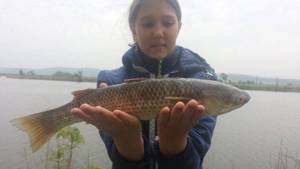
Description and photo

The outer parts of the eyes have a fatty eyelid with poor development. The leathery fold protruding beyond the edge of the mouth is the upper jaw of the fish. The weight of an ordinary mullet is up to 3 kg, length 600 mm, but favorable conditions of the southern seas and rivers allow the development of pelengas - and here the length can be 1500 mm with a weight of 7 kg. Fishermen managed to catch 12-kilogram specimens.
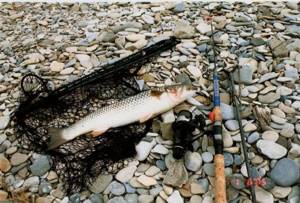
Differences between pelengas and mullet
Mullet is a sea fish, numbering 17 species, one of the subspecies is pelengas. It differs from its “relative” in that it quietly spends the night near the shore and can stay in fresh water for a long time. Often comes out to the upper layers of reservoirs and plays on the surface of the water. You can visually distinguish the sawfish from the mullet:
- it has a narrow and low dorsal fin;
- not afraid of warm water in shallow waters, feeds calmly in such conditions;
- The mullet has small scales and blue eyes; the pelengas has large scales, located even on the head, and orange eyes.
You can also distinguish fish in their finished form. Mullet has tender and tasty meat.
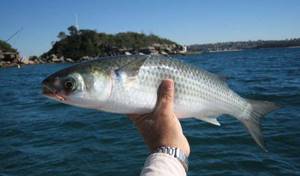
Where is pelengas found (pelengas in Kuban)
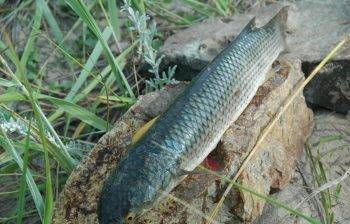
In the 70s, when sturgeon in the Sea of Azov began to decline, scientists brought the pelengas to the Kuban and Don. It took root in these conditions and began to be mined industrially. Now this is one of the most interesting rewards for fishing work. The main habitats for fish were the following areas:
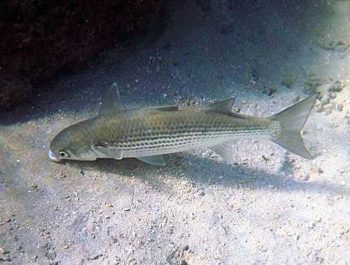
- Taganrog Bay;
- Berdyansk and Obitochny bays;
- Utlyuk and Molochny estuaries.
In these places, during the fish feast and its migration, you can meet fishermen from all over the south of the country and beyond.
The Black Sea, or Kuban, species of fish was brought here after an experiment by scientists in the Kerch Strait.
This subspecies likes to look for Inkitic worms, but the main food remains organic matter from the bottom layer.
During the fish feast, some fishermen caught trophy specimens using a simple earthworm of medium size and dark color.
